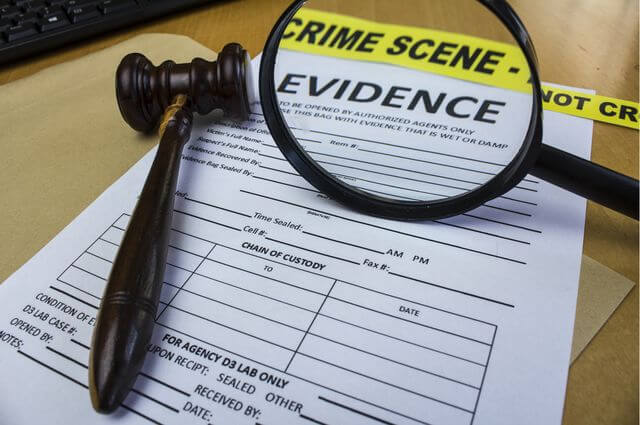This article is written by Drishti Miglani
Table of Contents
Abstract
Bipedalism is a defining feature of the human lineage. Heinous crime scenes often carry incomplete/broken bloodstained footprint impressions with them. Analysis of footwear characteristics, impressions, and trackways can provide an important shred of evidence in a crime scene investigation. We can’t predict anything with broken evidence unless and until we don’t have an accurate footprint impression.
Footprints and shoe-print can easily be distinguishable from each other. It becomes a tedious job to differentiate between shoe-print and footprint if it is messed up due to large variations in foot size, shoe size, and shoemaking. Hence, this is an attempt to analyze the structure of footprints and their impressions.
Keywords: Identification, Shoeprints, Footprints, Evidence, Crimes.
Introduction
Forensic Science is the application of science to criminal and civil laws, mainly on the criminal side during criminal investigation, as governed by the legal standards of admissible evidence and criminal procedure. It collects, preserves, and analyzes scientific evidence during an investigation. Due to the rapid increase in the crime rate, it becomes a crucial part of criminology.
Forensic Analysis refers to a detailed investigation for detecting a documenting the course, reasons, culprits, and consequences of the security incident or violation of rules of the organization or state laws. It has a major role in crime investigations.
All the marks and evidence left by the accused and the victim are collected and examined by them. While some forensic scientists travel to the scene of the crime to collect the shreds of evidence themselves, others occupy a laboratory role, performing analysis on objects brought to them by other individuals.
Modern Forensic Scientists perform comprehensive chemical and physical analysis of pieces of evidence submitted by law enforcement agencies. Their composition is often operant inappreciable and jailbird felons. The increasing sophistication of crime investigations has resulted in greater use of physical evidence.
The application of new technology to criminal and civil investigations has the effect of extending the limits of physical evidence. From this evolution of criminal investigation, procedures have come to a greater need for well-trained forensic scientists as well as initiatives for developing innovative approaches to educating students in science.
Footprints refer to the imprints left by the person walking. They play a very crucial role in the forensic analysis of the crime scene. It helps to identify all the individuals present at the commission of a crime. Traces of the footprints are collected and 3D Pictures of the same are captured for further analysis. Certain guidelines are followed by the photographer, to ensure further analysis of the foot impression.
In countries like India, where crime is not rare, manual analysis is a very time-consuming process. According to the records of the National Crime Control Bureau in 2012, the total number of violent crimes in India was 278417, out of which 25% was convicted.
Various types of footprints have been analyzed so far. Hoofprints or paw prints are the print left by the animals with hoofs or paws instead of feet whereas; shoeprints are the prints left by the shoe. These include latent print which is not visible to bare eyes. When a person walks on the floor being the floor and his/her foot dry, this leads to latent prints.
The other type is the patent or visible footprint. Such type of footprints is produced when the soles of the feet are wet and the impression of which is marked on the dry floor. This type of impression can be visible with naked eyes and is very efficacious for investigation purposes. In the case of an impressing footprint, the foot impression is left on the soft, pliable, or impressionable surface such as clay, molten wax surfaces, etc.
These impressions are very efficient for investigation purposes and can be dissected easily. Such can be viewed with naked eyes and can be outlooked and snapped without development.
Foot impressions reflect a lot about the individual and also the order in which the activities occurred. They provide various classes of information like Class A includes; type of the product or the thread which is used by the particular brand of the manufacturer or in the particular model; movement pattern of a person at a walk, run, trot, size of footwear.
All these do not necessarily comprise the activities of a specific individual. Class B includes; unique wearing patterns, cuts, and defects in the sole and the content of fragments caused by walking or other activity. After investigation, if an individual’s footwear shows some distinctive impressions comprising features of other classes and is associated with the crime scene, then it is giving identification.
In other words, the particular shoe was solemnly responsible for the marks at the crime scene, proving beyond the shadow of a doubt, providing that this was present as the person was wearing it. This might provide evidence in determining what happened.
Separate footprints enable the officer to determine how many individuals were present at the crime as it allows their number to be counted. It determines the velocity of the movement, also they were carrying any heavyweights with them or not. Additional marks or impressions could also be leftover from the footwear.
The level of involvement of the suspect and the timings of the activities are analyzed in the impression of the footprint. For instance, if a footwear impression is over-trodden by the impression of the footwear of the suspect, then this will depict that the maker of the trodden-over impression was present before the commission of the crime. It might be difficult to track out the time difference between the commission of the crime and the presence of the maker.
This supports and also dissatisfies the involvement and non-involvement in the crime. All the impressions questioned are suggested that they were made by someone happening onto the scene after the crime. They illustrate the interactions among the participants in the events. The pattern in which they are formed reveals who did what, in what order at the crime scene in a real-time manner.
A survey/study was conducted by taking various samples of the male and female footprint. Firstly, two groups are formed- male and female belonging to a specified range of ages. More or less equal numbers of males and females are considered at the same point.
Foot impressions depict age and gender. Different parts of the country are also reflected in the same. By using the method of correlation and coefficient the shoe length and foot-length were determined. The study had an accuracy prediction between 85-95%.
Gender identification/prediction with 95.6% accuracy was recorded for right foot measurements and 96.4% accuracy was recorded for left-foot measurement. The study for regional foot length and foot breadth showed 92% accuracy.
In these studies, the height and the width of the feet are recorded, then the mean is calculated, and then based on these values’ standard deviation of height and width is measured. Then based on these values’ correlation coefficient is calculated and regression analysis can be done to predict the status, sex of the person to whom the footprints belong to.
While tracing the footprints various difficulties are faced. Maximum footprints are broken which makes it a challenging task to trace and collect the impressions which make it hellacious to measure the height and width of the feet. Through various reconstruction procedures, an accurate impression can trace out. The necessary procedure is carried out.
Human Expert hangs on to obligatory and experienced to distinguish the footprint into 2 sets: bare footprint and shoe footprint. Then necessary techniques are applied for prediction. There are some of the automated machines introduced to trace out the impressions, but as it is rightly said, “some things are achieved from experiences and machines can never have the same efficiency as of humans”, therefore machines can’t be relied upon for the same. Various methods are being adopted to ensure the availability of accurate impressions of the footprint.
Linking forensic evidence with the crime ensure speedy trials and is the most efficient manner to hold out justice. The advanced technology not only provides forensic experts with advanced, upgraded experiments and discoveries but also with accuracy and quality with higher standards.
Admissibility of Forensic Science in Criminal Justice System
With technological advancements, the science expert has been rapidly increasing. The criminal justice system has developed and is more reliable on the scientific system for collecting evidence. Science can be used as a tool to curb out the best from criminal investigation. It can also help to investigate the matter efficiently, especially in criminal cases. Science and technology help to collect the shreds of evidence and to solve the crime, investigate, examine and evidence, suspected documents, detailed files, footprints bodily evidence.
After a crime is committed, a team of forensic experts approaches to collect the circumstantial evidence which could be tampered with due to delay. Forensic Science uses its disciplines and scientific expertise for law enforcement, criminal, civil and judicial matters. Various fields of science can be used in the criminal justice system accordingly, such as:
- Biology in the reproductive laws as well as DNA identification or biological aspects in an autopsy.
- Chemistry in the chemicals, drugs, and explosives, arms, and ammunition.
- Engineering in the identification of the structural design.
- Computer Science in the identification of cybercrime and how to deal with it.
The usage of science can help to prove the accused guilty or innocent. It helps to provide a linkage between the different aspects of crime. Calcutta was the prominent provincial state of the colonial era. The establishment of the forensic departments in India marked the advent of the importance of forensic aspects.
With the establishment of IPC, Evidence Act, CrPC, various amendments were required with the lapse of time, as the intensity of the crime and the rate at which crimes were increasing were way higher and were uncontrollable. Various parliamentary legislations and judicial decisions formulated the way deeper and strengthen the legal policy of the country.
Section 45 and 46 of the Indian Evidence Act, 1872, highlighted the importance and usage of fingerprints in the crimes, such as
- The court will ensure its whole faith in the expert dealing with the forensic aspects of the crime using scientific techniques.
- Ensuring the full-fledged faith in the person dealing with the hardcore facts of the case.
- If the experts feel the relevance of the evidence in the case, even if the court doesn’t, then the opinion of the expert will be given priority.
As the court works on the evidence and it must be sufficient, strong enough to prove the holder. DNA is one of the major pieces of evidence in the same. DNA gives 99% accurate results in case of positive and 100% result in case of negative.
Certain guidelines regarding DNA tests and their admissibility to prove parentage were laid down by the court, such as:
- Courts in India cannot order blood tests as a matter of course;
- Wherever applications are made for such prayers in order to have a roving inquiry, the prayer for blood tests cannot be entertained.
- There must be a strong prima facie case in that the husband must establish non-access in order to dispel the presumption arising under Section 112 of the Evidence Act.
- The court must carefully examine as to what would be the consequence of ordering the blood test; whether it will have the effect of branding a child as a bastard and the mother as an unchaste woman.
- No one can be compelled to give a sample of blood for analysis.
Section 53 and 54 of CrPC, 1973 impliedly provide DNA testing in complex criminal matters as there are no solid provisions for the same.
Section 53 empowers the examination of the accused by the medical practitioners at the request of the police officer if certain grounds are established, this examination provides evidence in the case. Section 54 empowers the court to enable the medical practitioner for the further examination of the accused on the various grounds deemed to be fit for the evidence.
The CMJ or CMM can provide for the examination of the fingerprints, footprints, semen, viscera, blood, hair, voice, of an, accused or reasonable suspected person involved in the commission of the crime on the request of the Investigating Officer under Section 27(1).
Postulates
Bloodstained footprints are traced on a herbarium sheet, which is further kept to dried up. Some basic guidelines of forensic science are then followed and from a fixed certain focal length, the images are captured. A couple of the scales are placed horizontally and vertically, to ensure that there is no sort of contortion of the footprints in the image.
If some artifacts or noise are traded on the image, then these are removed for proper differentiation of the shoe and footprint. The original image matrix of the blood-stained footprint is cropped from the whole image by removing scale artifacts and other background noises. This procedure is known as the pre-processing of the image which is necessary for the further processing of the image.
Pre-processing procedure
Creating an RGB image set by reading all the images from the database. Region of Interest (ROI) is identified and extracted which is also known as the red portion of the image. Numerous matrices are formulated comprising red, green, blue zone.
- The red portion is then analyzed and if the calculated value is less than α, it indicates the pixel is not red.
- Else this is considered as ROI.
- Various filters with window size 3*3 are applied.
- The pixel might contain equal or more than ?.
- The noise-free binary image set is obtained.
- The database contains images with 500*500 resolution.
- Therefore 3*3 window size variant filter is quite enough.
- The trial and error method has been used in previous studies which resulted in the value of ? and ? as 10 and 26 respectively.
A binary image is cropped by the following steps:
- Scan the image from the right major order.
- The first pixel with value zero is marked as the top boundary of ROI.
- Scanning of the image from the top in a row-major order is done.
- First-pixel containing value zero is considered as the bottom boundary of ROI.
- Now, the is set for further processing, where the image is much less than the original images.
- Therefore, the proposed method for partitioning into two stets is executed.
Every cropped binary image is examined to realize whether it is a bare footprint or shoe print. The top and the bottom-most point are stored safely for further investigation. The region lying to the left of the hypothetical line between the given two points is considered as left boundary, similarly right boundary points.
The image is divided into three equal parts along with the height of the image. Every segment is cross-checked that whether the values of left boundary points and right boundary points are increasing or decreasing. Each boundary, each segment is flagged if the value decreases flagged as one else zero. Now, the total number of MSER features of every image is calculated.
Results and Discussion
Both types of footprint i.e., bare footprint and shoeprint are shown here. The pre-processing methodology has been applied to these two figures and such results have been obtained. These are the cropped binary figure.
The recognition method through the automated system predicts the statue, gender, and other parameters from footprints images. Reconstruction of a broken footprint image will upgrade this discrimination procedure. For an image with a bigger resolution optimum solution can be devised.
Medico-Legal Importance of Footprints
Footwear marks the second most important evidence type left at crime scenes. It reveals a lot of crucial knowledge that may be of use to forensic investigators. The analysis of the same found a crime scene provides the following information:
A number of people at a crime scene
Various foot impressions recovered/traced out by the investigator indicate the number of personnel available at the crime scene. It provides an important clue that the number of members present at the crime scene was more than one.
The relative height of the wearer
There is a biserial correlation between the footwear size/ foot size, height, and also the length of the wearer. The distance between each consecutive footmark guide/assists the investigator in calculating the height of the wearer.
The activity of the wearer when the impression was made
Plastic footwear impression left on soft surfaces can reveal a lot about the movement of the person. It resembles whether the person was running, walking, or carrying a heavy load when the impression was made. The running impressions will be deeper in the heel and toe section whereas a person carrying heavy loads will leave imprints that are deeper than when not carrying a heavy load.
Manufacturer, model, and approximate size of footwear
Some manufacturing companies use unique patterns, threads, shapes, arrangements that form the outsole design. These are compared with the footwear outsole database to identify the model of the footwear. It ensures that the suspect list is narrowed down and also create a link between various crime scenes to the same perpetrators.
Creating the link between crime scene impression with a specific piece of footwear
This might so happen that the crime scene carries some pieces of the shoes of the victim or the assailant. Each shoe piece contains some unique attributes which are either acquired by the wearer by the wear and tear of the outsoles. These attributes are unique in their way and may belong to/ show the same characteristics as of the impression collected from the crime scene.
This leads to two conditions for the recognition
If the shoe size and class characteristics match
It may so happen that the shoe impression traced out from the crime scene has been made by the footwear with a similar design and size but not with the shoe worn by the person available at the crime scene or from the shoe whose piece has been discovered.
If the class characteristics, size matches, and also the characteristics found in the footwear outsole can also be found in the crime scene impressions
The investigator can conclude that there is a relation between the specific piece of shoe and crime scene impression. This can be used as a piece of major evidence to prove the availability of the footwear owner was present at the crime scene.
Conclusion and Suggestions
In this shadowy world of crime, the criminals are getting advanced and always try to come up with some new way or technique of committing the crime. A new technique of committing the murder was showcased in a case famously known as the “Kanpati Maar Case“.
Various other cases are also discussed in the Indian Code where the unique traits are used for the commission of the crime. But it has been noted down that criminals always leave his/her traces at the crime scene after they commit a crime, but it is not easy to detect them. A specialized team of forensic labs and tools are required to detect them.
These traces sometimes contain 80-90% of the information of the person present at the crime scene. It could be an assailant/victim or someone who assisted in the crime or the act. There has been a drastic change in the intensity of the crime for a decade.
Numerous weapons or tools are used for the commission of the crime with new unique attributes. To tackle the cases and to meet the advancement of the crime new, fully-featured, advanced techniques and equipment are required for the forensic study of the crime scene.
The crime scene carries impression evidence and the forensic experts are realizing the importance of the same. Although it becomes a backbreaking task to locate/trace out the footprints, fingerprints, or other impressed evidence.
There is some evidence of more prevalent fingerprints that provide greater clues to mysterious cases. Furthermore, forensic experts must be equipped with efficient laboratories to handle evidence in order to avoid the tamper of the same.
DNA tests must be granted freely in some other cases as well or where the accused failed to answer effectively to court. Doctors and forensic experts must be given priority and protection during trials. The trustworthy ness and admissibility should be granted in the law effectively
References
- https://science.howstuffworks.com/environmental/green-science/carbon-footprint.htm
- J Gordon Burrow, Bare Footprint Analysis Comparing Two Collection Methods Adopting the Reel Measurement System and Adobe Photoshop, eISSN: 2469-2794, Volume 2 Issue 2.
- https://medcraveonline.com/FRCIJ/bare-footprint-analysis-comparing-two-collection-methods-adopting-the-reel-measurement-system-and-adobe-photoshop.html
- Cyber Toolkit Allows Detectives to Follow a Criminal’s Digital Footprint, (Mar. 5, 2020),
- https://www.crimemuseum.org/crime-library/famous-murders/forensic-investigation-of-the-oj-simpson-trial/
- https://lupinepublishers.com/forensic-and-geneticsjournal/pdf/PRJFGS.MS.ID.000156.pdf
- http://www.legalserviceindia.com/article/l153-Forensic-Evidence.html
- http://14.139.60.114:8080/jspui/bitstream/123456789/681/10/Fingerprints%20and%20Footprints.pdf
LawSikho has created a telegram group for exchanging legal knowledge, referrals, and various opportunities. You can click on this link and join:
https://t.me/joinchat/J_0YrBa4IBSHdpuTfQO_sA
Follow us on Instagram and subscribe to our YouTube channel for more amazing legal content.
 Serato DJ Crack 2025Serato DJ PRO Crack
Serato DJ Crack 2025Serato DJ PRO Crack











 Allow notifications
Allow notifications


